15+ Sample Used Car Sales Receipts
-
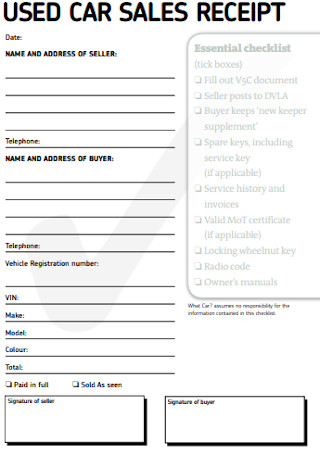
Used Car Sales Receipt Template
download now -

Used Car Purchase Receipt Template
download now -
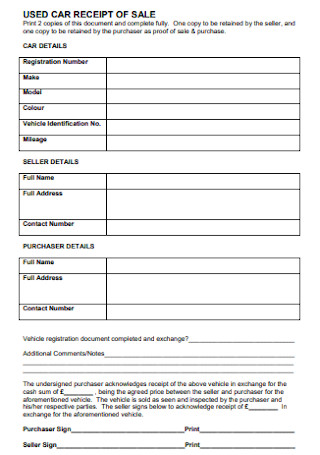
Used Receipt of Car Template
download now -
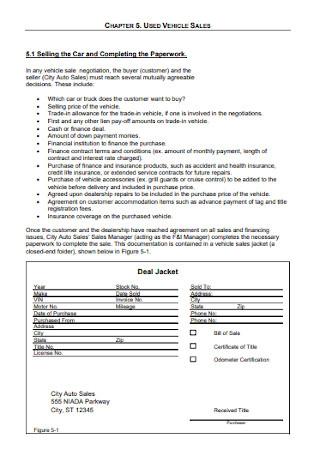
Used Vehicle Sale Receipt
download now -
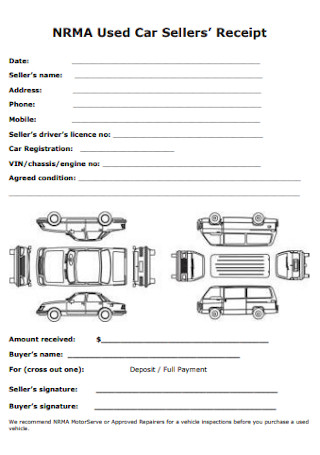
Used Car Sellers Receipt
download now -

Used Car Agreement Receipt
download now -
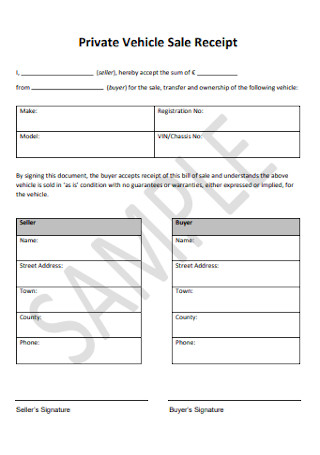
Private Vehicle Sale Receipt
download now -
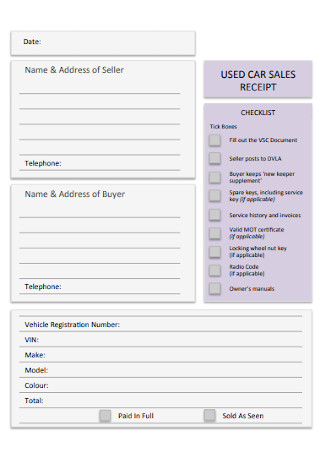
Simple Car Sales Receipt Template
download now -
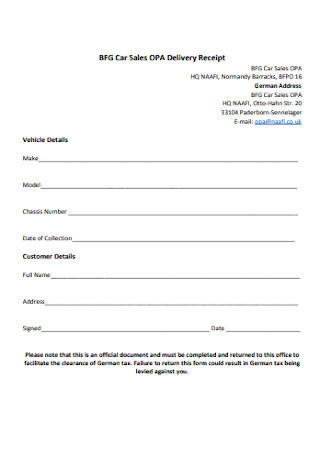
Car Sales Delivery Receipt
download now -
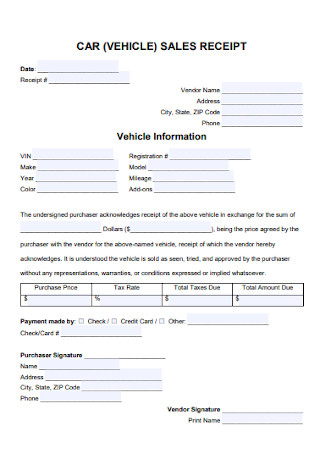
Basic Car Sales Receipt Template
download now -
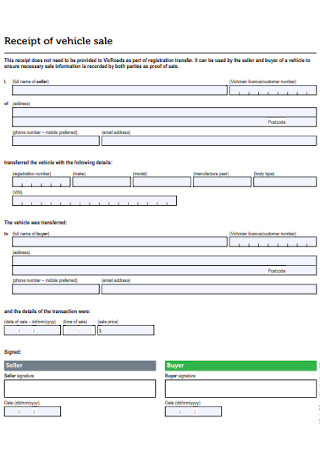
Receipt of Vehicle Sales Template
download now -

Your Car Sale Receipt
download now -
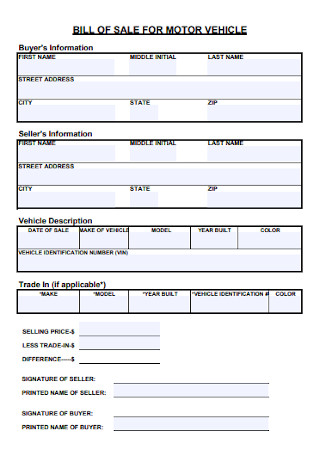
Motor Vehicle Sales Report
download now -

Sample Used Car Vehicle Receipt
download now -
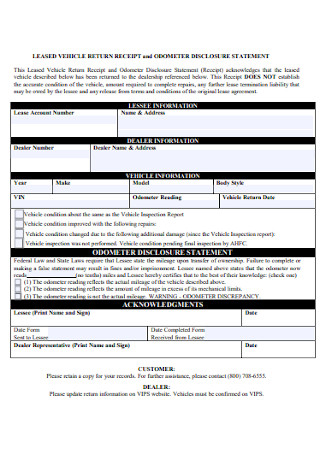
Vehicle Return Receipt Template
download now -
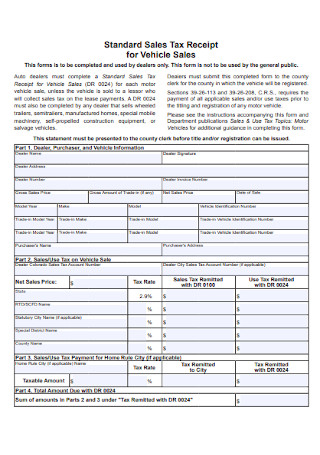
Sales Tax Receipt for Vehicle
download now
FREE Used Car Sales Receipt s to Download
15+ Sample Used Car Sales Receipts
What Is a Used Car Sales Receipt?
The Components of a Used Car Sales Receipt
How to Write a Used Car Sales Receipt
FAQS
What are the essential things to consider when purchasing a used car?
How do you negotiate for a better price for a used car?
Does mileage matter in acquiring a used car?
What Is a Used Car Sales Receipt?
A used car sales receipt is a sales document that details a purchase or a transfer of a car from the dealership to the buyer in writing. It includes the aspects of the transaction made between the two parties. The dealership or the seller also uses the receipt as documentation for internal order tracking. The customer also keeps the insurance receipt for various purposes, including identification, return, and reimbursement of funds. It serves as the client’s proof of purchase regarding how much and what they bought. A receipt or a bill of sale contract is a legal document that provides a transaction record. It states that the seller transferred the rights of the vehicle to the customer.
According to the research done and data collected by I. Wagner from Statista, there are approximately 40.42 million used cars sold in America during 2018. It is an overwhelming number compared to the 17.21 million sold brand new cars. It presents that Americans are still aiming to be practical that exuberant in terms of automobiles.
The Components of a Used Car Sales Receipt
A used car sales receipt has different components. All the necessary information found in the sales agreement document is a reference to the transfer of ownership. Since each state and each dealership or reseller uses various formats, it is significant to familiarize yourself with the information indicated in the receipt. Here are the components of a used car sales receipt to note.
How to Write a Used Car Sales Receipt
Upon knowledge of the details included in the sales receipt, a seller must know the steps in writing. It serves as a legal document for the new owner of the car and the seller, and making a mistake is not advisable for both parties. As a seller, it is essential to have a copy for records. The buyer also needs the documents for valid identification and transfer when necessary. Here are the steps in writing a used car receipt.
Step 1: Acquire a Medium for Creating the Receipt
A receipt can be written down or electronically made. Either one is an option for a seller. What’s important is that the template or the content of the receipt lists essential information regarding the sale made.
Step 2: State Information of Both Parties and Transaction Date
Include the buyer and the seller’s necessary information in the receipt. Include sentences that demonstrate the intent of the parties engaged in the agreement. Indicate which of the parties is the seller and the buyer. Include any information that both parties settled upon while the negotiation is in order.
Step 3: Detail the Vehicle’s Information
The vehicle’s information must be accurate and precise. The details must be complete for the safety and security of both parties. A car’s brand, manufacturer, date of manufacture, and color must be present. It must also include other distinguishing features of the vehicle. The most significant aspect about the car stated in the receipt is the Vehicle Identification Number (VIN). The VIN serves as a thumbmark and greatly distinguishes the auto apart from other vehicles of the same attributes.
Step 4: State the Total Price and Payment Options
Upon proper inspection checklist and identification of the vehicle, there is a settlement of the amount. The amount’s basis is on the condition of the car and the agreed-upon terms of both parties. The seller writes down the mode and duration of payment. If the buyer opts for partial installment, the receipt reflects the initial amount made. It must state when the next payment is due as well.
Step 5: Indicate the Condition of the Car
The sales receipt must also include the condition of the car upon purchase receipt. Stated defects of the car reflect on the document, and the statement of warrant is issued if it is available. The buyer must communicate properly with the seller for a just agreement. Only then can both parties sign the receipt.
FAQS
What are the essential things to consider when purchasing a used car?
It’s not a simple task to purchase a vehicle, let alone a used one. There are plenty of factors to consider when contemplating buying a used car. According to a market research report by IBIS World, a total of 144,431 dealerships that business used cars. Whether you are buying from a certified dealer or a private seller, providing yourself with knowledge considerably affects your decision-making process. Before going to a dealer, perform ample research and define the car you want. Research cars that fit into the description you want to have. Walking into a dealership without any idea of what you are looking for is impractical. The dealer can easily persuade you into buying any car. Prepare by researching and gathering information on a piece of paper or your phone. It is also essential to set a personal budget. Setting a price range helps you save money, narrow down the search and negotiate prices within your budget. It will be hard for the seller to talk you into increasing your budget if you are firm with your decision. It also helps if you give out an indefinite number and let the dealer start from there. It is advisable to consider all financing options. Paying in cash may look like the best option; however, you can also consider an auto loan with a great deal involved. Before any purchase, make sure to test drive the car. All may look good physically, but the best way to be sure is by taking the car out for a drive. Consider bringing someone knowledgeable about cars when looking for a vehicle. They can help verify if the auto is really in good shape.
How do you negotiate for a better price for a used car?
According to the Bureau of Transportation Statistics, the average price for new vehicles is approximately $30,000 in 2019. Meanwhile, used car prices average $20,000. The difference in prizes is considerably minimal between new and used cars. In answering the question, the best deal relies on negotiation skills. The amount of price deduction depends on the car’s worth, your financing capabilities, and how long the vehicle is for sale. You must perform enough research concerning the specifications of the auto you want and work your way from there. The most vital part of bargaining prices is the confidence you have in yourself. Never allow a salesperson or a dealer to intimidate you into securing a deal out of your comfort zone.
Does mileage matter in acquiring a used car?
As stated earlier, the mileage reading influences a car’s selling price. The lower the mileage recorded in the odometer, the higher the price will be. The odometer reading indicates the state of the car’s components where the devaluation of parts is prominent in vehicles used for a longer duration and great distances. A lesser mileage reading also means the fundamental elements of the car like breaks, suspensions, and engine are in good working condition. These are all just indicators of a well-kept vehicle. The best way to determine the overall condition of a car is through a mechanic’s meticulous inspection. It’s only then you can safely assume that the vehicle is in good working order.
Any kind of purchase is justified in terms of proper research and knowledge. The same goes for buying a used car. The smart goal of acquiring a used vehicle is to pay less with a good deal. If you lack research and finesse in negotiating prices, then it is best to walk away first. Familiarity with what you want will ensure the best deals possible. Assure you own an original copy of the sales receipt when the purchase is made final. It serves as a legal document in case complications arise. Also, guarantee that all fields in the release form are authentic and valid. In terms of negotiation, former president John F. Kennedy said, “Let us never negotiate out of fear. But let us never fear to negotiate.” Start negotiating for your car now, and familiarize yourself with the used sales receipt templates above.
